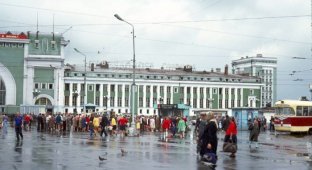In the 1950s in the USSR, unlike the USA, the creation of an atomic bomber was perceived not just as desirable, even very desirable, but as a vitally necessary task. This attitude was formed among the top leadership of the army and the military-industrial complex as a result of the awareness of two circumstances.

Firstly, the huge, overwhelming advantage of the United States in terms of the very possibility of atomic bombing the territory of a potential enemy. Operating from dozens of air bases in Europe, the Middle and Far East, US aircraft, even with a flight range of only 5-10 thousand km, could reach any point in the USSR and return back. Soviet bombers were forced to operate from airfields on their own territory, and for a similar raid on the United States they had to cover 15-20 thousand km. There were no aircraft with such a range in the USSR at all. The first Soviet strategic bombers M-4 and Tu-95 could “cover” only the very north of the United States and relatively small areas of both coasts. But even these machines numbered only 22 in 1957. And the number of American aircraft capable of striking the USSR had reached 1,800 by that time! Moreover, these were first-class bombers carrying atomic weapons B-52, B-36, B-47, and a couple of years later they were joined by supersonic B-58.
Secondly, the task of creating a jet bomber of the required flight range with a conventional power plant in the 1950s. seemed insurmountably difficult. Moreover, supersonic, the need for which was dictated by the rapid development of air defense systems. Flights of the first supersonic strategic carrier in the USSR, the M-50, showed that with a load of 3-5 tons, even with two refuelings in the air, its range can barely reach 15,000 km. But no one could answer how to refuel at supersonic speed, and what’s more, over enemy territory. The need for refueling significantly reduced the likelihood of completing a combat mission, and in addition, such a flight required a huge amount of fuel - a total of more than 500 tons for the refueling and refueling aircraft. That is, in just one flight a regiment of bombers could consume more than 10 thousand tons of kerosene! Even the simple accumulation of such fuel reserves grew into a huge problem, not to mention safe storage and protection from possible air strikes.

At the same time, the country had a powerful scientific and production base for solving various problems in the use of nuclear energy. It originated from Laboratory No. 2 of the USSR Academy of Sciences, organized under the leadership of I.V. Kurchatov at the very height of the Great Patriotic War - in April 1943. At first, the main task of nuclear scientists was to create a uranium bomb, but then an active search began for other possibilities use of a new type of energy. In March 1947 - only a year later than in the USA - in the USSR for the first time at the state level (at a meeting of the Scientific and Technical Council of the First Main Directorate under the Council of Ministers) the problem of using the heat of nuclear reactions in power plants was raised. The Council decided to begin systematic research in this direction with the aim of developing the scientific basis for generating electricity through nuclear fission, as well as propelling ships, submarines and aircraft.
However, it took another three years for the idea to make its way. During this time, the first M-4 and Tu-95 managed to take to the skies, the world's first nuclear power plant began operating in the Moscow region, and construction of the first Soviet nuclear submarine began. Our agents in the USA began to transmit information about the large-scale work being carried out there to create an atomic bomber. These data were perceived as confirmation of the promise of a new type of energy for aviation. Finally, on August 12, 1955, Resolution No. 1561-868 of the Council of Ministers of the USSR was issued, ordering a number of aviation industry enterprises to begin work on nuclear issues. In particular, OKB-156 by A.N. Tupolev, OKB-23 by V.M. Myasishchev and OKB-301 by S.A. Lavochkin were supposed to design and build aircraft with nuclear power plants, and OKB-276 by N.D. Kuznetsov and OKB-165 A.M. Lyulka - the development of such control systems.

The simplest technical task was assigned to OKB-301, headed by S.A. Lavochkin - to develop an experimental cruise missile "375" with a nuclear ramjet engine designed by M.M. Bondaryuk's OKB-670. The place of a conventional combustion chamber in this engine was occupied by a reactor operating in an open cycle - air flowed directly through the core. The design of the missile's airframe was based on developments on the 350 intercontinental cruise missile with a conventional ramjet engine. Despite its comparative simplicity, the theme “375” did not receive any significant development, and the death of S.A. Lavochkin in June 1960 completely put an end to these works.
Myasishchev’s team, then busy creating the M-50, was ordered to complete a preliminary design of a supersonic bomber “with special engines by chief designer A.M. Lyulka.” At the OKB, the topic received the index “60”, and Yu.N. Trufanov was appointed leading designer on it. Since in the most general terms the solution to the problem was seen in simply equipping the M-50 with nuclear-powered engines, operating in an open cycle (for reasons of simplicity), it was believed that the M-60 would become the first nuclear-powered aircraft in the USSR. However, by mid-1956 it became clear that the task posed could not be solved so simply. It turned out that the aircraft with the new control system has a number of specific features that aircraft designers have never encountered before. The novelty of the problems that arose was so great that no one in the OKB, and indeed in the entire mighty Soviet aircraft industry, had any idea how to approach their solution.

The first problem was protecting people from radioactive radiation. What should it be like? How much should it weigh? How to ensure the normal functioning of a crew enclosed in an impenetrable thick-walled capsule, incl. visibility from workplaces and emergency escape? The second problem is a sharp deterioration in the properties of conventional structural materials, caused by powerful flows of radiation and heat emanating from the reactor. Hence the need to create new materials. The third is the need to develop a completely new technology for operating nuclear aircraft and building appropriate air bases with numerous underground structures. After all, it turned out that after the open cycle engine stops, not a single person will be able to approach it for another 2-3 months! This means that there is a need for remote ground maintenance of the aircraft and engine. And, of course, there are safety problems - in the broadest sense, especially in the event of an accident of such an aircraft.
Awareness of these and many other problems did not leave stone unturned from the original idea to use the M-50 airframe. The designers focused on finding a new layout, within the framework of which the mentioned problems seemed solvable. At the same time, the main criterion for choosing the location of the nuclear power plant on the aircraft was considered to be its maximum distance from the crew. In accordance with this, a preliminary design of the M-60 was developed, in which four nuclear-powered turbojet engines were located in the rear fuselage in pairs on “two floors”, forming a single nuclear compartment. The aircraft had a mid-wing design with a thin cantilever trapezoidal wing and the same horizontal tail located at the top of the fin. Missile and bomb weapons were planned to be placed on the internal sling. The length of the aircraft was supposed to be about 66 m, the take-off weight was to exceed 250 tons, and the cruising flight speed was 3000 km/h at an altitude of 18,000-20,000 m.

The crew was supposed to be placed in a solid capsule with powerful multi-layer protection made of special materials. The radioactivity of the atmospheric air excluded the possibility of using it for cabin pressurization and breathing. For these purposes, it was necessary to use an oxygen-nitrogen mixture obtained in special gasifiers by evaporating liquid gases on board. The lack of visual visibility had to be compensated for by periscopes, television and radar screens, as well as the installation of a fully automatic aircraft control system. The latter was supposed to provide all stages of the flight, including takeoff and landing, reaching the target, etc. This logically led to the idea of an unmanned strategic bomber. However, the Air Force insisted on a manned version as more reliable and flexible in use.

Nuclear turbojet engines for the M-60 were supposed to develop a take-off thrust of about 22,500 kgf. OKB A.M. Lyulka developed them in two versions: a “coaxial” design, in which the annular reactor was located behind the conventional combustion chamber, and the turbocharger shaft passed through it; and “yoke” schemes - with a curved flow path and the reactor extending beyond the shaft. Myasishchevites tried to use both types of engines, finding both advantages and disadvantages in each of them. But the main conclusion, which was contained in the Conclusion to the preliminary draft of the M-60, sounded like this: “... along with the great difficulties of creating the engine, equipment and airframe of the aircraft, completely new problems arise in ensuring ground operation and protecting the crew, the population and the area in the event of an emergency landing. These problems... have not yet been solved. At the same time, it is the ability to solve these problems that determines the feasibility of creating a manned aircraft with a nuclear engine.” Truly prophetic words!
In order to translate the solution to these problems into a practical plane, V.M. Myasishchev began developing a project for a flying laboratory based on the M-50, on which one nuclear engine would be located in the forward part of the fuselage. And in order to radically increase the survivability of nuclear aircraft bases in the event of the outbreak of war, it was proposed to abandon the use of concrete runways altogether, and turn the nuclear bomber into a supersonic (!) M-60M flying boat. This project was developed in parallel to the land version and maintained significant continuity with it. Of course, the wing and engine air intakes were raised above the water as much as possible. Take-off and landing devices included a nose hydroski, ventral retractable hydrofoils and rotary lateral stability floats at the ends of the wing.

The designers faced the most difficult problems, but the work progressed, and it seemed that all the difficulties could be overcome in a time period that was significantly less than increasing the flight range of conventional aircraft. In 1958, V.M. Myasishchev, on instructions from the Presidium of the CPSU Central Committee, prepared a report “The State and Possible Prospects of Strategic Aviation,” in which he unequivocally stated: “...In connection with significant criticism of the M-52K and M-56K projects [bombers on conventional fuel - author] The Ministry of Defense, in view of the insufficient range of action of such systems, it seems to us useful to concentrate all work on strategic bombers on the creation of a supersonic bomber system with nuclear engines, providing the necessary flight ranges for reconnaissance and for targeted bombing by suspended aircraft-projectiles and missiles against moving and stationary targets."

Myasishchev had in mind, first of all, a new project of a strategic missile-carrying bomber with a closed-cycle nuclear power plant, which was designed by the N.D. Kuznetsov Design Bureau. He expected to create this car in 7 years. In 1959, a “canard” aerodynamic design with delta wings and a significantly swept front empennage was chosen for it. Six nuclear turbojet engines were supposed to be located at the rear of the aircraft and combined into one or two packages. The reactor was located in the fuselage. Liquid metal was supposed to be used as a coolant: lithium or sodium. The engines could also run on kerosene. The closed operating cycle of the control system made it possible to make the cockpit ventilated with atmospheric air and significantly reduce the weight of the protection. With a take-off weight of approximately 170 tons, the weight of the engines with heat exchangers was assumed to be 30 tons, the protection of the reactor and cockpit was 38 tons, and the payload was 25 tons. The length of the aircraft was about 46 m with a wingspan of approximately 27 m.
The first flight of the M-30 was planned for 1966, but Myasishchev's OKB-23 did not even have time to begin detailed design. By decree of the OKB-23 government, Myasishchev was involved in the development of a multi-stage ballistic missile designed by V.N. Chelomey OKB-52, and in the fall of 1960 it was liquidated as an independent organization, made branch No. 1 of this OKB and completely reoriented to rocket and space topics. Thus, OKB-23's groundwork for nuclear aircraft was not translated into real designs.






















